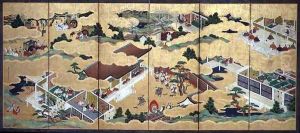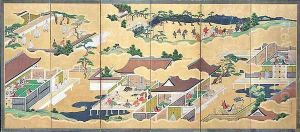Fujiwara Tsunenobu Paintings
Fujiwara Tsunenobu, born in 1648 and died in 1728, was a Japanese painter and calligrapher during the Edo period, a time marked by the rule of the Tokugawa shogunate and characterized by economic growth, strict social orders, isolated foreign policies, and a flourishing of arts and culture. Tsunenobu was a member of the esteemed Kano school, which played a dominant role in Japanese painting for more than four centuries, influencing the development of Japanese art significantly.
The Kano school, founded by Kano Masanobu in the late 15th century, was known for its blend of Chinese-inspired themes and Japanese aesthetics, producing works that were both bold and subtle. As a member of this school, Tsunenobu contributed to its legacy by creating works that adhered to the school's stylistic principles while also infusing his unique perspective and technique. He specialized in screen paintings and fusuma (sliding door) panels, often depicting themes from nature, such as birds, flowers, and landscapes, which were popular subjects in Japanese art due to their symbolic meanings and aesthetic appeal.
Tsunenobu's accomplishments were not only limited to his artistic creations but also included his contributions to the Kano school's pedagogy and administration, ensuring the transmission of its techniques and philosophy to future generations. His works were highly valued by the shogunate and the feudal lords, contributing to the prestige of the Kano school during a period when art patronage was a significant aspect of cultural life in Edo Japan.
Despite the passage of time, Fujiwara Tsunenobu's legacy endures, with his works preserved in several important Japanese cultural institutions and collections worldwide. These pieces continue to be studied and admired for their beauty, craftsmanship, and historical significance, offering insights into the rich artistic heritage of the Edo period and the enduring appeal of the Kano school's artistic vision.

